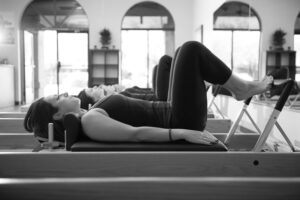Pilates for Runners: Injury Prevention and Performance
Running, one of the most accessible and popular forms of cardiovascular exercise, offers numerous health benefits, from improving heart health to boosting mental well-being. However, the repetitive nature of running often leads to a high risk of injury and can sometimes hinder performance if not complemented with cross-training. Pilates emerges as a powerful ally for runners, focusing on core strength, flexibility, and mindful movement, making it an ideal practice for injury prevention and enhancing running performance.
Here are the five benefits of pilates for runners:
- Strengthening the Core for Stability
- Enhancing Flexibility and Range of Motion
- Improving Breathing and Oxygen Efficiency
- Balancing Muscular Strength
- Encouraging Mind-Body Connection
Strengthening the Core for Stability
A strong core is crucial for runners, as it stabilizes the torso, reduces pelvic wobble, and increases efficiency in movement. Pilates targets the deep abdominal muscles, the back, and the muscles around the pelvis, known collectively as “the powerhouse”. A strengthened core from regular pilates practice helps runners maintain optimal form, especially during long runs or at the end of a race when fatigue sets in, minimizing the risk of injury.
Enhancing Flexibility and Range of Motion
Tight muscles can limit a runner’s stride length and speed while increasing the risk of injuries such as runner’s knee, IT band syndrome, and hamstring strains. Pilates promotes flexibility through dynamic stretching exercises, which not only improve muscle elasticity but also enhance joint range of motion. This increased flexibility allows for more efficient and fluid running movements, contributing to better performance.
Improving Breathing and Oxygen Efficiency
Pilates emphasizes proper breathing techniques, teaching runners to use their breath more efficiently. By learning to breathe deeply and fully, runners can improve oxygen delivery to their muscles, enhance endurance, and perform better. Additionally, the focus on rhythmic breathing in pilates helps runners develop a more relaxed and focused mindset, essential for tackling challenging distances.
Balancing Muscular Strength
Runners often develop muscular imbalances due to the repetitive forward motion of the sport, which can lead to overuse injuries. Pilates addresses these imbalances by strengthening underused muscle groups and stretching overused ones. This balanced approach to muscle conditioning can prevent common running injuries, such as shin splints and stress fractures, by ensuring that no muscle group is overstressed.
Encouraging Mind-Body Connection
Pilates requires mindfulness and concentration on movement, aligning the body and mind. This practice can help runners become more attuned to their bodies, noticing early signs of fatigue or strain that may indicate injury risk. Additionally, the mental focus developed through pilates can enhance mental toughness on the track or road, improving overall performance.
Incorporating Pilates into Your Running Routine
To reap the benefits of pilates for running, consider incorporating pilates sessions into your training schedule 1-2 times per week. Start with basic exercises focusing on core strength, flexibility, and alignment, and gradually incorporate more advanced techniques as your body adapts.
Pilates offers a comprehensive approach to cross-training for runners, addressing key aspects of injury prevention and performance enhancement. By strengthening the core, improving flexibility, balancing muscular strength, and fostering a strong mind-body connection, pilates can help runners achieve their full potential while minimizing the risk of injury. Whether you’re a casual jogger or a competitive racer, integrating pilates into your training regimen can lead to significant improvements in your running journey.
Our pilates classes in our Scottsdale studio can help runners improve their performance while also mitigating the risk of injury. Contact Simply Pilates to learn more!



